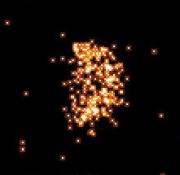Planets & Comets
Probably the most surprising objects observed in X-rays are comets. Comets were described by Fred Whipple as being "dirty snowballs". So how does a snowball make X-rays? Through a phenomenon called charge exchange. The Sun is constantly streaming ions into the Solar system. Also called the Solar wind, the ions are so highly charged that they will steal electrons from cold gas if possible. A comet becomes active when it gets close to the Sun and it starts putting cold gas out into space. This is when charge exchange can occur.
This charge exchange takes place every time an ion gets close to a cold gas molecule, and each time this happens, an X-ray is emitted. This makes comets very bright in X-rays. Comets are so bright that some scientists think we will be able to see comets around other stars in X-rays.
Planets have also been detected in X-rays, including the Earth. In addition to charge exchange, which was used to deduce that Mars is losing its atmosphere to space, the most common mechanism is fluorescence. Venus, Jupiter and Saturn have all been detected in X-rays and the physics surrounding the generation of X-rays on each planet has proven to be unique
HEA: Scott Wolk
AMP: Vasili Kharchenko




